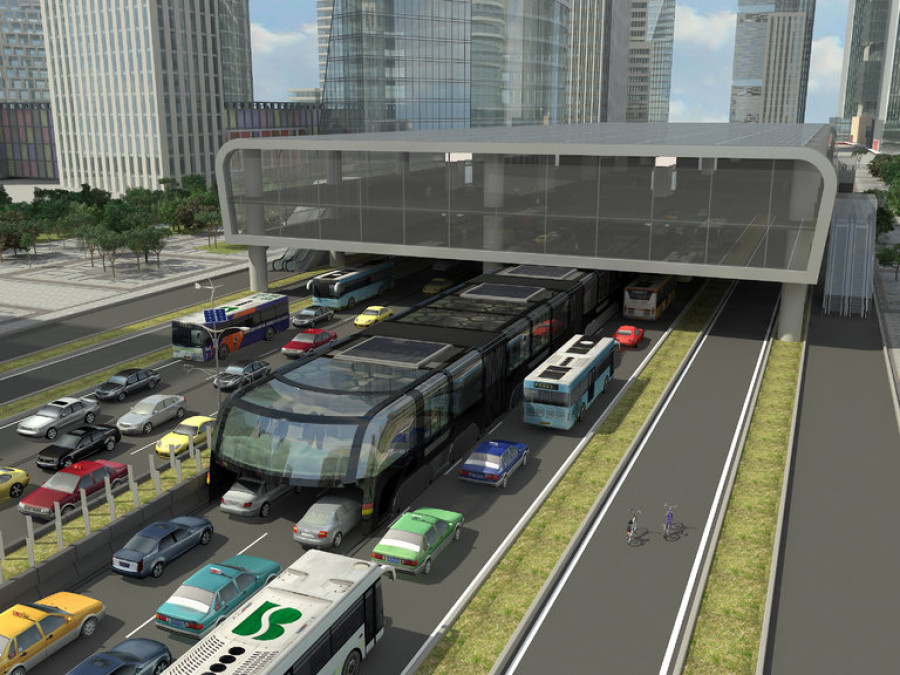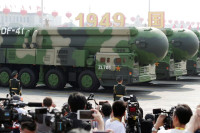World
Bus project finds a way around China’s traffic jams: Gliding above them (with video)
A model for a giant, elevated bus was presented over the weekend at the Beijing International High-Tech Expo, though it was not the first time that what has been called a “straddling bus” had been proposed. The bus first made an appearance at the Beijing expo in 2010, but doubts about the project led to the cancellation of a trial run.
The New York Times
A model for a giant, elevated bus was presented over the weekend at the Beijing International High-Tech Expo, though it was not the first time that what has been called a “straddling bus” had been proposed. The bus first made an appearance at the Beijing expo in 2010, but doubts about the project led to the cancellation of a trial run.
Six years later, Song Youzhou, the designer of the bus, says that prototypes are being constructed. In an interview this week, he said that five Chinese cities — Nanyang, Qinhuangdao, Shenyang, Tianjin and Zhoukou — have signed contracts with his TEB Technology Development Company for pilot projects that will involve the construction of hundreds of miles of tracks starting this year.
The cost of each bus will run about 30 million renminbi, or about $4.5 million, which Mr. Song put at one-sixteenth the price of a subway train. Buses were already under construction in Changzhou, Jiangsu Province, he said.
The elevated bus attracted international attention when the design was first unveiled in 2010 and was chosen by Time Magazine as one of the 50 best inventions that year. But it also attracted skepticism that the proposal could deliver on its promises.
The bus, powered in part by solar energy, would run on tracks, carrying up to 1,200 passengers in raised compartments that can glide over the traffic below. Critics at the time it was first unveiled questioned whether the hovering bus could interact safely with other vehicles. They also argued that the tracks would require relatively straight roads not found in many older urban areas, and that the overhead boarding stations that the bus needed would take up too much space.
Mr. Song responded in the Chinese news media that he had arranged to have Shanghai Jiao Tong University’s Institute of Automotive Engineering to assess the feasibility of his design.
However, the institute’s director, Yin Chengliang, denied in an interview with the newspaper Southern Weekend that he had any involvement with Mr. Song. The institute’s vice director and two professors said in the same report that they had conducted a design analysis, but that it was a personal initiative. Based on their assessment, the professors said, the design was “basically feasible” but “not perfect.”
Shortly thereafter, a planned pilot project in the western Beijing district of Mengtougou was canceled. The director of the district’s science and technology commission told Southern Weekend, “News of the bus was overblown and attracted the displeasure of some people, which is probably why it was killed.”
Since 2010, Mr. Song said in the interview this week, Lanzhou University, Tongji University and Xi’an Jiaotong University have all approved the bus design after conducting separate audits.
He dismissed his critics, calling them “so-called entrepreneurs and companies with their own interests.”
In February, local governments approached Mr. Song with renewed interest in the bus as an environmentally efficient way to ease congestion, officials said. According to a 2015 study conducted by TomTom, a Dutch navigation company, nearly one-third of the world’s 50 most congested cities in the world were Chinese.
“In 2010, the bus was only a dream, but now it is in a mature stage,” said Wang Peng, director of the Shenyang chamber of commerce. After meeting with Mr. Song and assessing the safety of the bus technology, the Shenyang city government signed an agreement this month to build about 12 miles of elevated bus tracks for testing, Mr. Wang said.
“The elevated bus merges existing, mature technology found in railroads, subways and buses,” Mr. Wang said. “The only question is now how it will interact with other traffic once implemented.”
To prevent traffic accidents, Mr. Song said guardrails would be constructed between the bus tracks and the car lanes that pass through the elevated bus. The rails would be able to absorb at least 70 percent of a collision’s impact to reduce damage to the bus and other vehicles. Lanes for the elevated bus would be limited to passenger vehicles no higher than 7.2 feet, and the buses are designed to meet zoning and bridge height regulations in each city.
Mr. Song said the buses were fully capable of turning corners, though the cars underneath must wait until the buses have passed before turning themselves.
“People didn’t understand the technology before,” he said. “But now that the government supports entrepreneurship and innovation, our earlier critics haven’t said anything.”




 10.12°C Kathmandu
10.12°C Kathmandu














